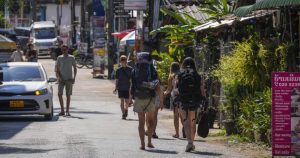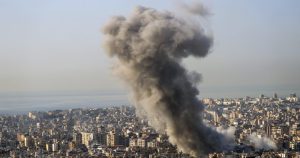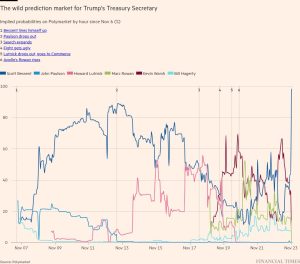Inside Israel’s push into the undergrowth of southern Lebanon
From the vantage of a hilltop inside southern Lebanon, it is clear the terrain of Israel’s land war has moved from the urban ruins of Gaza to a tangle of dense undergrowth.
Brush and thick green forests stretch across steep hillsides, marking a front considered more rugged than areas farther east where Israeli troops have engaged Hizbollah fighters in Lebanese border villages.
The Israel Defense Forces took a group of journalists into Lebanon on Sunday, showing them arid woodland paths and outcrops where Israeli officers said the militant group Hizbollah has established forward operating bases.
The tunnels, bunkers and weapons caches gradually uncovered over the past fortnight were, Israel claims, part of preparations for a potential cross-border assault.
To counter the threat, Israel has billed its invasion force, consisting of some four divisions and an estimated 20,000 troops, backed by one of the most fierce air campaigns mounted beyond its borders, as a “limited and precise” offensive into Lebanon.
But its forces are now moving across a sprawling, harsh terrain that has wrongfooted generations of Israeli soldiers, whose pushes into Lebanon have a history of flawed tactics and long occupations.

“Undergrowth war is more complex than urban fighting. It has no logic and you can’t take shortcuts,” said Brigadier General Yitzhak Norkin, the commander of the IDF’s 146th Division, responsible for the far-western sector of the offensive.
Despite Israel’s insistence that this operation is limited, the UN estimates that nearly a quarter of Lebanon’s territory is under an evacuation order from the Israeli military. Israel has told about 140 communities in south Lebanon to flee their homes since October 1, ordering residents to move north of the Awali river, which runs at least 80km north of the southern tip of Lebanon.
Norkin said Israel’s goal was to remove Hizbollah’s capacity to threaten Israel and allow 60,000 Israelis to return to their homes, after being evacuated when the Lebanese movement began firing on northern Israel a day after Hamas’s October 7 attack.
So far Norkin’s division, the IDF’s largest and made up solely of reservists, has not entered the Lebanese villages farther northward. Since it joined the invasion force last week, he said, the focus has been on “cleaning” this small strip of land tucked a few hundred metres inside a massive Israeli-built border wall.


In one square kilometre, Israeli officers said, the IDF battalion operating in the area had found around 100 Hizbollah military positions, including a tunnel 10 meters deep and 50 meters wide with firing positions for mortars and anti-tank guided missiles. Another weapons cache was filled with army kit, small arms, mines and explosive devices.
“You can’t take a step [in this area] without coming across Hizbollah [military] infrastructure,” said Ariel, an IDF officer in the division. “And without forces physically on the ground you can’t clear out this area from this . . . infrastructure because of the tunnels and the forests.”
Multiple Israeli officers were incredulous that the UN peacekeepers in the area, some in a base located less than 200 meters from a Hizbollah tunnel, had not detected the extensive building project.
Unifil has also come under fire from Hizbollah in the past. In 2022, an Irish peacekeeper was killed and another seriously injured when their armoured patrol car was attacked in a Hizbollah-controlled area.
Senior Israeli officials have said over the past two weeks that the peacekeepers are “not the enemy” and have only “suggested” they leave southern Lebanon. However, several international troops in this sector have recently been injured by Israeli fire. Norkin called them regrettable “mistakes”, while also blaming one incident on Hizbollah.
Over the past year, Israel’s offensive against Hizbollah has killed more than 2,000 people and forced some 1.2mn from their homes, mostly over the past three weeks. On the Israeli side, over 50 people have been killed by incoming Hizbollah fire since the start of the war, in addition to 10 Israeli soldiers since the launch of the ground incursion earlier this month.

From inside southern Lebanon, Israeli artillery thuds in the distance and the growl of fighter jets above were an incessant reminder that this was an active war zone. And Israeli forces have taken incoming mortar and drone attacks themselves from Hizbollah.
Yet the militants had mostly retreated northward to the village line ahead of the Israeli incursion, ceding the area to the IDF, according to Israeli officers. Norkin admitted no “face-to-face” combat had broken out yet with Hizbollah fighters in the area.
Instead, Norkin said “slow and meticulous” progress had been made, given the need to keep his troops safe and the time needed to find and eliminate what they say are hundreds more Hizbollah positions in this sector alone.
Inside one thicket of baby oak trees, along a path originally cut by Hizbollah but widened more recently by the IDF, little was visible either from above or in a 360 degree turn.
“The enemy can be standing 5 metres from you and you won’t know it,” said one veteran Israeli reservist, clutching his assault rifle.
If this specific sector of the IDF’s offensive is any indication, the Israeli ground offensive in Lebanon will be measured in weeks and months rather than days. Norkin fought in the last Israel-Hizbollah war in 2006 as a young tank commander. That conflict lasted for over a month, and ended with the Middle East’s most powerful military bogged down in a stalemate. Yet this time, he said, was very different.

“Now [during this offensive] we are getting into much more complicated areas — the forests, the bushes. In 2006 we didn’t do it. We went around these areas. We didn’t fight here,” Norkin said, pointing around at the area his forces now held, with armoured personnel carriers, tanks and infantry kicking up dust clouds on the rocky access roads.
Later on he admitted that the sheer scale of southern Lebanon — “a huge territory” — would make it difficult to “destroy everything” Hizbollah had built.
The group, the region’s most heavily armed non-state actor, has controlled southern Lebanon since Israel ended its occupation in 2000. It is also Lebanon’s dominant political force and deeply embedded in the social fabric of the country’s south.
There is already talk at the top levels of the Israeli military and political leadership about a diplomatic arrangement that would, like previous UN Security Council resolutions, call for Hizbollah to withdraw from the border region, which would be demilitarised save for international peacekeepers and the Lebanese army. Yet prior agreements have not been implemented by either side.
It is an open question whether even Israeli officials believe such an arrangement will meet their objectives and provide real security. Nor, many Lebanese wonder, will it arrive soon enough to halt the spiralling death toll inside their country.
Mark, nearing 70 years of age, has been fighting in Lebanon and other Israeli battlefronts for over four decades, since Israel’s first ground invasion of its northern neighbour in 1978. Now one of the oldest reservists in the IDF, he is stoic about the prospects of this latest offensive.
“I guess we may need to stay here and hold a small security zone again, but that’s just my opinion,” he said, referring to Israel’s 18-year occupation in the 1980s and 1990s of the very hills around which he was now navigating his armoured personnel carrier — another paratrooper shepherding journalists to see yet another Israeli war in southern Lebanon.
This story was viewed by the Israeli military censors as a condition of accompanying troops into Lebanon. Nothing was changed as a result.
#Israels #push #undergrowth #southern #Lebanon





